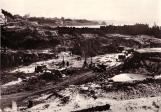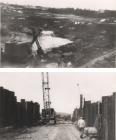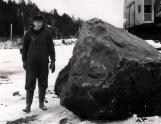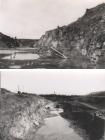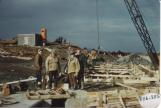15
DYNAMITING A CANAL BED THROUGH BALHACHE POINT Creating a suitable channel for shipping traffic through Balhache Point required more than just blasting through dry land. Drill scows were used, preparing a channel in the rock deep enough for commercial vessels to enter.17
COFFERDAM NECESSARY - December 16th,1953 - Looking south from Station 16+00. Excavation inside south cofferdam. The community of Port Hastings was on the immediate left. September 14th, 1953- Looking west inside south cofferdam. Down at end- T.R. Moore and Romeo Laroque who worked for T.C. Gorman, the contractor for the building of the Canso Canal. O.J. McCulloch whose engineering company was responsible for the job walks up towards them.These and other original pictures which were taken by Harry MacKenzie belong to the Port Hastings Historical Society
19
DRILL SCOWS NEEDED - Sam Embree, a driller with T.C. Gorman Limited, worked aboard one of the drilling vessels and explains how the process worked."I worked on the drill scows that drilled [the approaches]... The water was so deep they needed a drill scow there. The engineer would say he wanted to have 50 feet of water when you were done, but sometimes you had 40 feet of rock to drill through. So you had a six inch drill and you put a casing down then you'd drill down through the casing."
21
DYNAMITING PART OF THE JOB - "The engineer would tell you how much dynamite to put in. The dynamite was 18 inches long and five inches around three sticks weighed between 47 and 51 pounds. We'd put caps in it and we'd put wires to it and we'd put a lobster trap buoy on it and drop it down through the pipe. Then you'd take the pipe up, hook all the wires together, and pull off and blast. Then we'd do it all over again." (Sam Embree, Port Hawkesbury, July 2004)23
The concrete walls of the Canso Canal were formed and anchored into solid rockMay, 1954
Canso Canal work site

24
INGREDIENTS FOR CONCRETE - Over 120,000 tons of crushed stone and 50,000 tons of sand were used in the concrete mixture.26
CEMENT SILO AND TRAIN CARSThe cement that went into the concrete that went into making the Canso Canal arrived by rail. Lennan MacDonald of T.C. Gorman Ltd. was responsible for receiving shipments.
"In my time there were 477 rail cars of cement, now that's bulk cement. We had bags, as well, in case we ran out, but it was bulk cement. We had a silo and a compressor and we pumped it in from the cars into the silo. I don't know what the capacity of those cars was, but there were 477 cars I logged in in my time there."
Pictured here, at top, the cement silo structure looms high over the job site. The bottom picture shows the process of dry cement arrival at the job site. The train cars pulled up to the silo, and the load was transferred.
